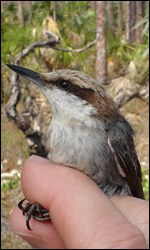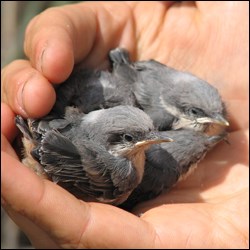
The range of the Brown-headed Nuthatch (Sitta pusilla) is restricted to mature pine forests of the southeastern states, where it is considered a species of concern. Although found almost exclusively in the United States, a small but declining population, considered a subspecies, is also found in the Bahamas. This small, charismatic bird is known for climbing headfirst down tree trunks. Although tool use in birds is rare, this species will hold a small piece of bark in its bill and use it as a lever to pry up bark while searching for insects. It may carry the bark tool from tree to tree and use it to cover a seed cache. The Brown-headed Nuthatch is one of several cavity-nesting birds that were extirpated from southeastern Florida in the mid-1900s as a result of habitat loss. During 1997-2001, 53 Brown-headed Nuthatches were reintroduced to Long Pine Key in Everglades National Park as part of a test of the progress made toward restoration of the rare pine rockland ecosystem. 
Monitoring through the 2003 breeding season determined that the reintroduced population consisted of 46 adults and 47 juveniles and was substantially greater than it was at the end of the translocation period in 2001. The nuthatch reintroduction program met previously defined population size and demographic success criteria: the population increased in all years of the study and reproduction and survival were similar between the reintroduced population and a high quality reference site. The nuthatch population in Everglades National Park was monitored until 2007, when the reintroduction effort was determined to be a success. The population reached its peak in size in 2005, with 86 adults and 60 offspring produced. Population size declined in 2006 and 2007, perhaps due to Hurricanes Wilma and Katrina in the fall of 2005. However, recent surveys indicate that population size as well as distribution in Everglades National Park both have increased beyond their levels in 2005. The success of the reintroduction program suggests that management activities have made progress in restoring the pine rockland ecosystem in Everglades National Park. Restoration efforts in the uplands have generally been overlooked within the south Florida landscape, in part because connections between uplands and hydrology are not as apparent as they are in other southern Florida ecosystems. Hydrology undoubtedly plays a role, but the extent and mechanisms of that role and the ecological services that pinelands provide within the landscape remain unclear. There is a critical need for research that explores the ecological relationships between uplands and hydrology, and how fire, the primary disturbance factor in this system, interacts between the two. Cavity-nesters such as nuthatches appear to be an ideal species for this research, as the disappearance of more than 40 percent of the total cavity-nesting community from the pine rocklands in Everglades National Park suggests that population may be the most sensitive responder to ecosystem change. ADDITIONAL RESOURCES Ecostudies Institute Publications |
Last updated: October 17, 2017
